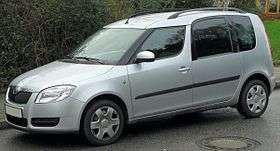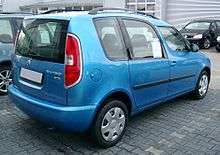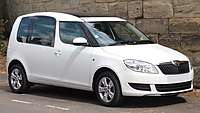Škoda Roomster
The Škoda Roomster (Type 5J) is a MPV-styled leisure activity vehicle, produced by the Czech automaker Škoda Auto. It was revealed as a production model in March 2006 at the Geneva Auto Show,[2] with sales beginning in June 2006. It was built at the Škoda factory in Kvasiny, Rychnov nad Kněžnou District.
| Škoda Roomster (5J) | |
|---|---|
 | |
| Overview | |
| Manufacturer | Škoda Auto |
| Production | 2006–2015 |
| Assembly | Kvasiny, Czech Republic (until 2011) Vrchlabí, Czech Republic (2011–2013) Kvasiny Czech Republic (2013–2015) Solomonovo, Ukraine (Eurocar) Kaluga, Russia[1] |
| Designer | Thomas Ingenlath |
| Body and chassis | |
| Class | Leisure activity vehicle (Roomster) Panel van (Praktik) |
| Body style | 5-door MPV 5-door panel van |
| Layout | Front-engine, front-wheel-drive |
| Platform | Volkswagen Group A04 (PQ24) platform (front) Volkswagen Group A4 (PQ34) (rear) |
| Powertrain | |
| Engine | 1.2 L I3 HTP (petrol) 1.2 L I4 TSI (petrol) 1.4 L I4 16V (petrol) 1.6 L I4 16V (petrol) 1.2 L I3 TDI CR (diesel) 1.4 L I3 TDI PD (diesel) 1.6 L I4 TDI CR (diesel) 1.9 L I4 TDI PD (diesel) |
| Transmission | 5-speed manual 6-speed tiptronic 7-speed DSG |
| Dimensions | |
| Wheelbase | 2,617 mm (103.0 in) |
| Length | 4,205 mm (165.6 in) |
| Width | 1,684 mm (66.3 in) |
| Height | 1,607 mm (63.3 in) |
| Chronology | |
| Successor | Škoda Kodiaq (for Roomster MPV/LAV) |
A five-door, two-seater panel van version, named the Škoda Praktik, was launched in March 2007. There was speculation that production would end in 2014, and on 30 April 2015, the last Roomster rolled off the production line in Kvasiny. Decreased demand could be blamed on the Yeti.
Overview
The Roomster is based on the concept car of the same name, originally revealed in September 2003 at the Frankfurt Auto Show. The concept was slightly shorter – 4,055 mm (159.6 in) against 4,205 mm (165.6 in) – than the production model but has a longer wheelbase – 2,710 mm (106.7 in) against 2,617 mm (103.0 in), and featured a single rear sliding door on the passenger side, which was replaced by two conventionally hinged swinging rear doors. Like the production car it was designed by Thomas Ingenlath and Peter Wouda.

_TDI_van_02.jpg)
The production Roomster (premiered at the 2006 Geneva Motor Show) is Škoda's first car since the Volkswagen Group's takeover of the brand that is not based entirely on an existing Volkswagen Group platform – although it is fundamentally based on the A4 (PQ34) platform, but with some unique additions. It shares components with the first generation Škoda Octavia[2] and the second generation Škoda Fabia.
The name is reportedly a conscious combination of the words 'Room' and 'Roadster', and the split personality theme is played out in the design with a carefully honed 'Driving Room' ahead of the B pillars, and a generous 'Living Room' to the rear. The front ‘Driving Room‘ is tailor-made to comply with the driver's requirements for a sporty cockpit.
The rear ‘Living Room‘ is aimed at creating roomy ambiance with the so-called ‘Cinema Effect‘ with higher seating and lower edge of windows. Škoda conceived the Roomster's cabin in a way it can have different configurations at the choice of the user.
The 'VarioFlex' rear seat arrangement[2] can be folded in a 40–20–40 split configuration, instead of the more usual 40–60, and can also be moved longitudinally and transversely (by removing the middle seat). The rear seats also have variable inclination up to 7° to the back, or completely to the front[3]Airy ambiance in the interior could be enhanced by optional one-piece panoramic sunroof.
The luggage compartment can have a completely flat surface with the rear seats completely removed, and the surface's height can also be modified with an amplitude of 250 mm (9.8 in). With the rear seats removed, the Roomster's luggage compartment has enough room to carry a bicycle.[4] The Roomster therefore competes both in the mini MPV and leisure activity vehicle markets, which it will be sharing with the FIAT Idea, Nissan Note, Opel Meriva, Citroën C3 Picasso and Volkswagen Golf Plus.
When launched, the Škoda Roomster took its internal combustion engines from its Volkswagen Group relatives, all engines were inline four-stroke designs. Petrol engines included the multi valve inline three cylinder 1.2 litre, with power initially DIN rated at 47 kilowatts (64 PS; 63 bhp) kilowatts, but with launch of the second generation Fabia rated at 51 kilowatts (69 PS; 68 bhp), followed by the 1.4-litre and 1.6-litre inline four-cylinder EA111 engines, with power of 63 kilowatts (86 PS; 84 bhp) and 77 kilowatts (105 PS; 103 bhp) respectively. The 1.6-litre was also available with a six-speed tiptronic automatic transmission.
Diesel engine propulsion came from the inline three-cylinder 1.4 Turbocharged Direct Injection (TDI), with two power levels, base at 51 kilowatts (69 PS; 68 bhp) and "sport" at 59 kilowatts (80 PS; 79 bhp). The top option was a four-cylinder 1.9 TDI, with 77 kilowatts (105 PS; 103 bhp).
The Roomster was available with a different colour for the roof. Customers could combine standard body colours (both solid and metallic) with white, black, and silver roof. The same concept was used for the hatchback Fabia, too. The rugged version of the Roomster – the Scout, was launched in 2007.
Safety
Facelift
The facelifted Roomster was premiered at the 2010 Geneva Motor Show, together with the Fabia models. The updated version can be easily distinguished by different shapes of the front bumper and front fog lights. Inside, new steering wheels were the tell-tales. Though their shape remained the same, headlights with the projector module undergone technical changes: for full beam, a separate reflector is fitted on the inner side of the lamp, while the projector module providing a dimmed beam is on the outer side.
The engine line up was updated along with a facelift, too. 1.2 litre TSI turbocharged petrol engines came as a replacement of the previous 1.4 and 1.6 litre MPI engines, providing significant improvements to fuel consumption and corresponding reductions in CO2 emissions.
The Aisin automatic transmission previously used was also replaced with the seven speed DSG dual-clutch gearbox (optional on 77 kilowatts (105 PS; 103 bhp) 1.2 TSi models), providing a reduction of over 30% in CO2 emissions for the 77 kilowatts (105 PS; 103 bhp) automatic derivative (compared to the previous 1.6 litre). Diesel engines were updated to the common rail system and four valve technology.
The GreenLine model received new technology, as well. Manufacturer's combined consumption for the Roomster GreenLine with brand new 55 kW 1.2 litre three cylinder diesel engine is 4.2 l/100 km, which is 109 g CO2 per km.
 Škoda Roomster SE TDI (UK – facelift)
Škoda Roomster SE TDI (UK – facelift) Škoda Roomster SE TDI (UK – facelift)
Škoda Roomster SE TDI (UK – facelift)
Related models
There was a five door two seat panel van version of the Roomster called the Škoda Praktik (Typ 5J8). Its cargo space is 1,605 millimetres (63.2 in) long, 1,016 millimetres (40.0 in) wide (minimum), and 900 millimetres (35.4 in) in height – giving a cargo load space of 1,900 litres (67.1 cu ft), and a payload from 550 to 640 kilograms (1,213 to 1,411 lb). It also includes a moveable internal load bulked, 'hidden' underfloor storage, anti slip load bay floor covering with six lashing points, and full length roof rails.
The model was never sold in the United Kingdom in RHD.
Engines
Overview of engines available for the Roomster (Typ 5J), incl. Praktik and facelifted model.
| Engine designation | Production | Engine code (family) | Displacement, configuration, valvetrain, fuel system, aspiration | Motive power at rpm | max. torque at rpm | Gearbox (type), drive | Top speed | 0–100 km/h [s] (0–62 mph) | Combined consumption [l/100 km / mpg imp / mpg US] | CO2 [g/km] |
|---|---|---|---|---|---|---|---|---|---|---|
| 1.2 HTP 47 kW | 2006 | (EA111) | 1198 ccm, I3, 6V, OHC, MPI, naturally aspirated | 47 kW (64 PS; 63 hp) at 5400 rpm | 112 Nm. (83 lb•ft) at 3000 | 5-speed manual (MQ200), FWD | 155 km/h (96 mph) | 16.9 | 6.8 / 41.5 / 34.6 | 163 |
| 1.2 MPI 51 kW | 2006–2015 | (EA111) | 1198 ccm, I3, 12V, DOHC, MPI, naturally aspirated | 51 kW (69 PS; 68 hp) at 5400 rpm | 112 Nm. (83 lb•ft) at 3000 | 5-speed manual (MQ200), FWD | 159 km/h (99 mph) | 15.9 | 4.7 / 60.1 / 50.0 | 124 |
| 1.2 TSI 63 kW | 2010–2015 | CBZA (EA111) | 1197 ccm, I4, 8V, OHC, TSI, turbocharged | 63 kW(86 PS; 85 hp) at 4800 rpm | 160 Nm. (118 lb•ft) at 1500–3500 rpm | 5-speed manual (MQ200), FWD | 172 km/h (107 mph) | 12.6 | 5.7 / 49.6 / 41.3 | 134 |
| 1.2 TSI 77 kW | 2010–2015 | CBZB (EA111) | 1197 ccm, I4, 8V, OHC, TSI, turbocharged | 77 kW (105 PS; 103 hp) at 5000 rpm | 175 Nm. (129 lb•ft) at 1500–4100 | 5-speed manual (MQ200), FWD | 184 km/h (114 mph) | 10.9 | 5.7 / 49.6 / 41.3 | 134 |
| 1.2 TSI 77 kW | 2010–2015 | CBZB (EA111) | 1197 ccm, I4, 8V, OHC, TSI, turbocharged | 77 kW (105 PS; 103 hp) at 5000 rpm | 175 Nm. (129 lb•ft) at 1500–4100 | 7-speed automatic (DQ200), FWD | 184 km/h (114 mph) | 11.0 | 5.7 / 49.6 / 41.3 | 134 |
| 1.4 MPI 63 kW | 2006–2015 | (EA111) | 1390 ccm, I4, 16V, DOHC, MPI, naturally aspirated | 63 kW (86 PS; 85 hp) at 5000 rpm | 132 Nm. (97 lb•ft) at 3800 rpm | 5-speed manual (MQ200), FWD | 172 km/h (107 mph) | 12.6 | 6.4 / 44.1 / 36.7 | 149 |
| 1.6 MPI 77 kW | 2006–2015 | (EA111) | 1598 ccm, I4, 16V, DOHC, MPI, naturally aspirated | 77 kW (105 PS; 103 hp) at 5600 rpm | 153 Nm. (113 lb•ft) at 3800 rpm | 5-speed manual (MQ200), FWD | 183 km/h (114 mph) | 11.3 | 6.9 / 40.9 / 34.1v | 165 |
| 1.6 MPI 77 kW | 2006–2015 | (EA111) | 1598 ccm, I4, 16V, DOHC, MPI, naturally aspirated | 77 kW (105 PS; 103 hp) at 5600 rpm | 153 Nm. (113 lb•ft) at 3800 rpm | 6-speed automatic (AQ250) FWD | 180 km/h (112 mph) | 12.5 | 7.5 / 37.7 / 31.4 | 180 |
| Engine designation | Production | Engine code (family) | Displacement, configuration, valvetrain, fuel system, aspiration | Motive power at rpm | max. torque at rpm | Gearbox (type), drive | Top speed | 0–100 km/h [s] (0–62 mph) | Combined consumption [l/100 km / mpg imp / mpg US] | CO2 [g/km] |
|---|---|---|---|---|---|---|---|---|---|---|
| 1.2 TDI CR 55 kW | 2010–2015 | (EA189) | 1199 ccm, I3, 12V, DOHC, common-rail, turbocharged | 55 kW (75 PS; 74 hp) at 4200 rpm | 180 Nm. (133 lb•ft) at 2000 rpm | 5-speed manual (MQ250), FWD | 162 km/h (101 mph) | 15.5 | 4.5 / 62.8 / 52.3 | 119 |
| 1.2 TDI CR GL 55 kW | 2010–2015 | (EA189) | 1199 ccm, I3, 12V, DOHC, common-rail, turbocharged | 55 kW (75 PS; 74 hp) at 4200 rpm | 180 Nm. (133 lb•ft) at 2000 rpm | 5-speed manual (MQ250), FWD | 165 km/h (103 mph) | 15.4 | 4.2 / 67.3 / 56.0 | 109 |
| 1.4 TDI PD 51 kW | 2006–2010 | (EA188) | 1422 ccm, I3, 6V, SOHC, Pumpe-Düse, turbocharged | 51 kW (69 PS; 68 hp) at 4000 rpm | 155 Nm. (114 lb•ft) at 1600–2800 rpm | 5-speed manual (MQ250), FWD | 163 km/h (101 mph) | 14.8 | 4.8 / 58.9 / 49.0 | 127 |
| 1.4 TDI PD DPF 59 kW | 2006–2010 | (EA188) | 1422 ccm, I3, 6V, SOHC, Pumpe-Düse, turbocharged | 59 kW (80 PS; 79 hp) at 4000 rpm | 195 Nm. (144 lb•ft) at 2200 rpm | 5-speed manual (MQ250), FWD | 172 km/h (107 mph) | 13.3 | 4.8 / 58.9 / 49.0 | 127 |
| 1.6 TDI CR 66 kW | 2010–2015 | CAYB (EA189) | 1598 ccm, I4, 16V, DOHC, common-rail, turbocharged | 66 kW (90 PS; 89 hp) at 4200 rpm | 230 Nm. (170 lb•ft) at 1500–2500 rpm | 5-speed manual (MQ250), FWD | 171 km/h (106 mph) | 13.3 | 4.7 / 60.1 / 50.0 | 124 |
| 1.6 TDI CR 77 kW | 2010–2015 | CAYC (EA189) | 1598 ccm, I4, 16V, DOHC, common-rail, turbocharged | 77 kW (105 PS; 103 hp) at 4000 rpm | 250 Nm. (184 lb•ft) at 1500–2500 rpm | 5-speed manual (MQ250), FWD | 181 km/h (112 mph) | 11.5 | 4.7 / 60.1 / 50.0 | 124 |
| 1.9 TDI PD DPF | 2006–2010 | (EA188) | 1896 ccm, I4, 8V SOHC, Pumpe-Düse, turbocharged | 77 kW (105 PS; 103 hp) at 4000 rpm | 240 Nm. (177 lb•ft) at 1900 rpm | 5-speed manual (MQ250), FWD | 182 km/h (113 mph) | 10.8 | 5.0 / 56.5 / 47.0 | 130 |
References
| Wikimedia Commons has media related to Škoda Roomster. |
| Wikimedia Commons has media related to Škoda Praktik. |
- Skoda Roomster
- "Škoda Roomster has space aplenty". TopGear.com. 26 January 2006. Retrieved 27 January 2010.
- "SKODA ROOMSTER 2014 1.G Owner's Manual". www.carmanualsonline.info. Retrieved 19 March 2017.
- Roomster accessories brochure 2011
- "Skoda Roomster". Euro NCAP. Retrieved 27 January 2010.
External links
- Škoda Roomster – Škoda Auto Official Website
- Škoda Praktik – Škoda Auto Official Website
- Škoda Roomster – Škoda UK Website
- BRISKODA.net – Škoda Roomster Forum and Community